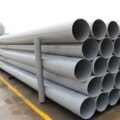average investment > Redefining Business Spaces: The Growing Significance of Fabric Structures
Redefining Business Spaces: The Growing Significance of Fabric Structures
Fabric structures represent innovative engineering solutions that combine sturdy frames, frequently crafted from steel or aluminum, with high-quality fabric membranes. Their application is rapidly expanding across various industries, ranging from manufacturing and warehousing to event venues and even healthcare facilities.
The surge in their popularity is unmistakable, driven by the revolutionary potential of fabric structures to transform the concept of space for businesses. They provide a flexible, cost-effective, and sustainable alternative to conventional brick-and-mortar buildings, effectively setting new benchmarks for operational efficiency and environmental responsibility.
The Evolution of Fabric Structures The idea of fabric structures has ancient origins, with historical roots in civilizations that employed animal hides stretched over wooden frames for shelter. However, modern iterations, often referred to as tension fabric buildings, have witnessed significant advancements in materials science and engineering. These breakthroughs have propelled fabric structures into the 21st century, making them the preferred solution for a multitude of applications.
Today, tension fabric buildings are routinely embraced across a wide array of industries. In manufacturing, they are employed as cost-effective, rapidly deployable warehouses and production facilities. The agriculture sector benefits from their exceptional ventilation properties when storing equipment and produce.
Event planners prize them for creating temporary venues, thanks to their flexibility and easy customization. Even sectors such as aviation and military operations are adopting fabric structures for applications like hangars and tactical shelters.
The burgeoning prominence of fabric structures is not just a fleeting trend but rather a reflection of their intrinsic advantages. Their adaptability and versatility render them suitable for diverse applications, meeting the dynamic demands of modern businesses requiring both agility and efficiency.
Key Advantages of Fabric Structures Fabric structures offer an array of benefits that contribute to their increasing adoption across various industries. These advantages are not solely operational but also financial, making them an attractive option for businesses. Here are some of the primary benefits:
- Cost-Effectiveness: Fabric structures are cost-effective due to lower construction and maintenance expenses. The materials and labor involved in these structures are generally more budget-friendly compared to traditional buildings. Furthermore, the durability of the materials used reduces the need for frequent maintenance, further trimming long-term costs.
- Swift Installation: The modular design of fabric structures enables rapid assembly and disassembly. This swift installation allows businesses to become operational in a shorter timeframe, effectively addressing market demands more efficiently.
- Versatility: Fabric structures are highly customizable and suitable for a wide range of applications. Their modular nature enables easy adjustments, affording businesses the flexibility to adapt to changing requirements. Whether for storage, manufacturing, or event hosting, these structures can be tailored to specific needs.
These key advantages highlight why fabric structures are an excellent choice for businesses seeking both agility and efficiency.
Materials and Design The efficacy of fabric structures hinges on two critical factors: the materials used and the design engineering. Both elements work in concert to provide the durability, versatility, and cost-effectiveness for which these structures are renowned.
Types of Materials Used: High-quality materials are essential for the longevity and performance of fabric structures. Polyvinyl is often chosen for the fabric membrane due to its resistance to weather conditions and UV rays. Galvanized steel is a common choice for the frame, offering strength and resistance to corrosion. These materials are not just selected for their individual merits but also for how well they complement each other, creating a cohesive, durable structure.
Design and Engineering: The design and engineering aspects are equally crucial for the durability of fabric structures. Advanced engineering techniques ensure the structure can withstand various environmental conditions, from high winds to heavy snow loads. The design also plays a role in the structure’s versatility, allowing for customization to meet specific business needs. Well-engineered fabric structures offer not just durability but also flexibility, making them suitable for a wide range of applications.
These factors collectively make fabric structures a reliable and efficient choice for modern businesses.
Sustainability and Energy Efficiency In the current business landscape, sustainability and energy efficiency are not mere catchphrases but fundamental criteria for any infrastructure investment. Fabric structures excel in both these dimensions, making them an increasingly popular choice for environmentally conscious businesses.
Eco-Friendly Materials and Construction Methods: Fabric structures often employ eco-friendly materials. For instance, the polyvinyl used in the fabric membrane is recyclable, reducing waste and promoting sustainability. Additionally, the construction methods for fabric structures are generally less resource-intensive than traditional buildings.
Energy-Saving Features: Many of these buildings come with features like high-quality insulation and options for natural lighting. The insulation helps maintain a stable internal temperature, reducing the need for heating or cooling systems. Natural lighting options, such as translucent fabric panels, minimize the need for artificial lighting during daytime hours. These features contribute to lower energy consumption, aligning with sustainability goals and reducing operational costs.
Fabric structures stand out as a green and efficient choice for today’s businesses. Their sustainability and energy-saving features make them an investment in both the planet and the bottom line.
Future Trends As fabric structures continue to gain traction in various industries, it’s essential to look ahead at emerging trends that are poised to further enhance their utility and adoption.
Smart Fabrics With Integrated Technology: One of the most exciting developments in this field is the emergence of smart fabrics. These materials incorporate integrated technology, such as sensors or conductive fibers, that can monitor environmental conditions. The inclusion of advanced technology into fabric structures opens up new possibilities for automation and real-time monitoring, enhancing operational efficiency.
Growing Adoption in Unconventional Sectors: While fabric structures have traditionally found a home in industries like manufacturing and agriculture, their versatility is leading to increased use in less conventional sectors. For instance, healthcare facilities are beginning to utilize fabric structures for temporary clinics or isolation units. Similarly, the education sector is exploring these structures for temporary classrooms or outdoor learning spaces. This diversification in application showcases the adaptability of fabric structures and hints at their broader potential.
The future of fabric structures appears promising, marked by technological advancements and expanding applications.
Conclusion As we look ahead, it’s evident that fabric structures are more than just temporary solutions; they are strategic assets for modern businesses. With advances in material science and growing adoption across diverse sectors, these structures are poised to play a pivotal role in shaping the future of business spaces.
In summary, fabric structures offer a blend of benefits that make them invaluable resources for today’s businesses. Their evolving role suggests a transformative impact on how we think about and utilize business spaces in the years to come.



